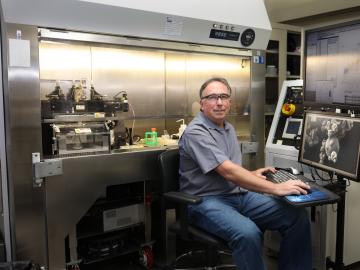
Filter News
Area of Research
- Biological Systems (2)
- Biology and Environment (18)
- Clean Energy (22)
- Climate and Environmental Systems (2)
- Computational Engineering (1)
- Computer Science (2)
- Data (1)
- Fusion and Fission (1)
- Materials (15)
- National Security (17)
- Neutron Science (5)
- Nuclear Science and Technology (2)
- Nuclear Systems Modeling, Simulation and Validation (1)
- Supercomputing (34)
Date
News Topics
- 3-D Printing/Advanced Manufacturing (2)
- Advanced Reactors (1)
- Artificial Intelligence (22)
- Big Data (28)
- Bioenergy (3)
- Biology (5)
- Biomedical (6)
- Biotechnology (2)
- Buildings (3)
- Chemical Sciences (2)
- Clean Water (2)
- Climate Change (17)
- Computer Science (32)
- Coronavirus (2)
- Cybersecurity (3)
- Decarbonization (2)
- Emergency (1)
- Energy Storage (1)
- Environment (24)
- Exascale Computing (6)
- Frontier (6)
- Fusion (1)
- Grid (5)
- High-Performance Computing (12)
- Hydropower (2)
- Isotopes (1)
- ITER (1)
- Machine Learning (11)
- Materials Science (5)
- Mathematics (2)
- Microscopy (2)
- Molten Salt (1)
- Nanotechnology (4)
- National Security (17)
- Net Zero (1)
- Neutron Science (2)
- Nuclear Energy (3)
- Physics (4)
- Quantum Science (1)
- Security (3)
- Simulation (6)
- Space Exploration (1)
- Statistics (1)
- Summit (8)
- Sustainable Energy (5)
- Transportation (5)
Media Contacts

We have a data problem. Humanity is now generating more data than it can handle; more sensors, smartphones, and devices of all types are coming online every day and contributing to the ever-growing global dataset.

As the second-leading cause of death in the United States, cancer is a public health crisis that afflicts nearly one in two people during their lifetime.

Oak Ridge National Laboratory will partner with Cincinnati Children’s Hospital Medical Center to explore ways to deploy expertise in health data science that could more quickly identify patients’ mental health risk factors and aid in

Researchers across the scientific spectrum crave data, as it is essential to understanding the natural world and, by extension, accelerating scientific progress.

For nearly three decades, scientists and engineers across the globe have worked on the Square Kilometre Array (SKA), a project focused on designing and building the world’s largest radio telescope. Although the SKA will collect enormous amounts of precise astronomical data in record time, scientific breakthroughs will only be possible with systems able to efficiently process that data.

Students often participate in internships and receive formal training in their chosen career fields during college, but some pursue professional development opportunities even earlier.

In the vast frozen whiteness of the central Arctic, the Polarstern, a German research vessel, has settled into the ice for a yearlong float.

Scientists at the U.S. Department of Energy’s Oak Ridge National Laboratory have demonstrated a way to isolate and grow targeted bacteria using genomic data, making strides toward resolving the grand challenge of uncultivated microbial “dark matter” in which the vast majority of microorganisms remain unstudied in the laboratory.

Processes like manufacturing aircraft parts, analyzing data from doctors’ notes and identifying national security threats may seem unrelated, but at the U.S. Department of Energy’s Oak Ridge National Laboratory, artificial intelligence is improving all of these tasks.

Using the Titan supercomputer at Oak Ridge National Laboratory, a team of astrophysicists created a set of galactic wind simulations of the highest resolution ever performed. The simulations will allow researchers to gather and interpret more accurate, detailed data that elucidates how galactic winds affect the formation and evolution of galaxies.


